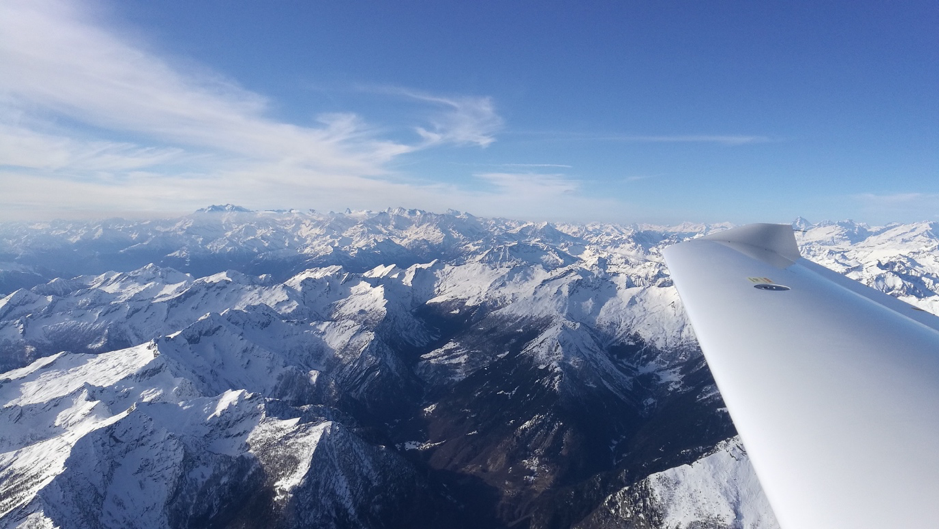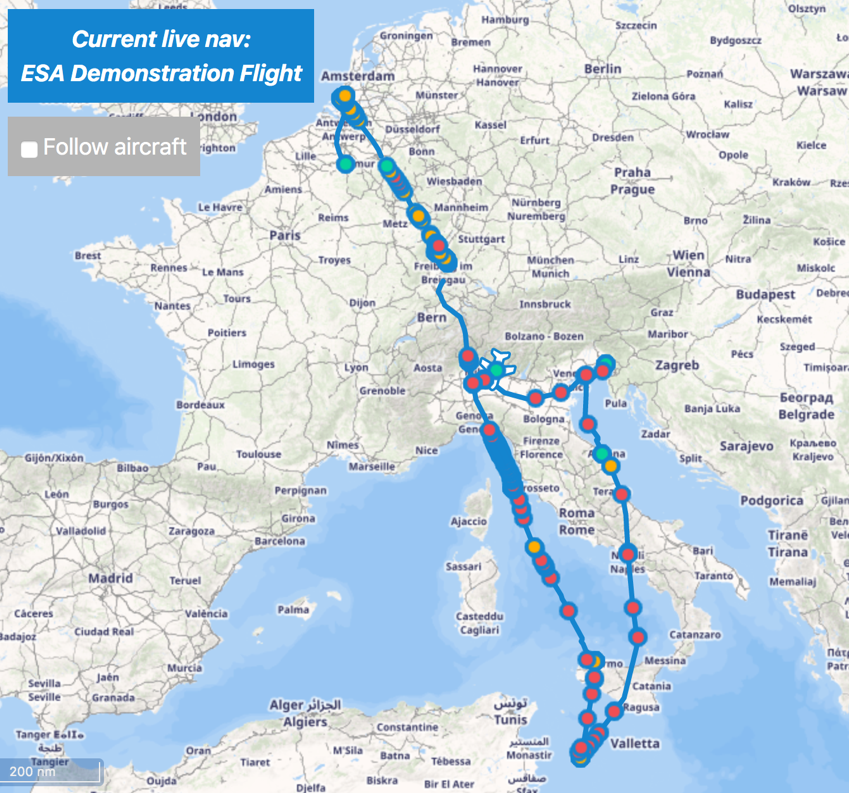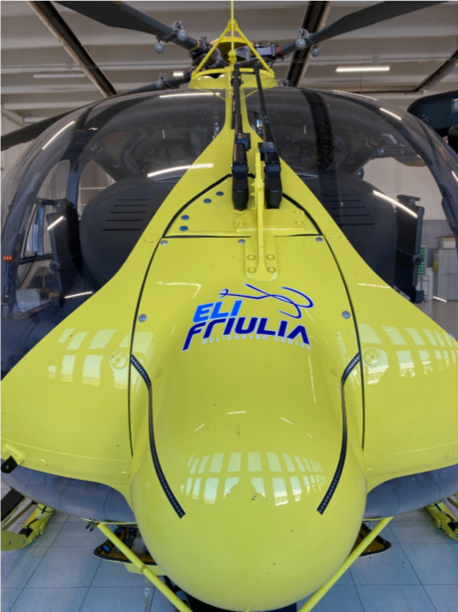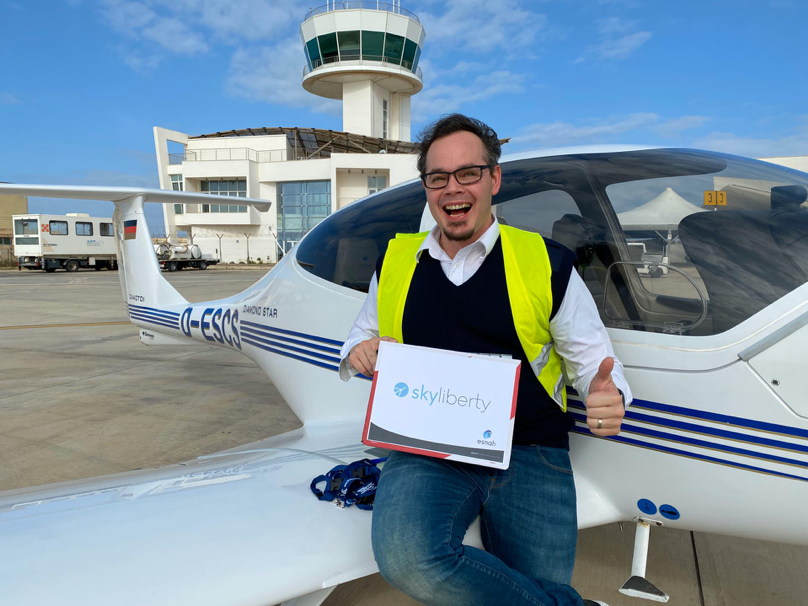SME ESNAH followed incubation at ESA BIC Belgium with a highly successful ESA Space Solutions Demonstration project that has seen its SkyLiberty flight navigation service, based on satellite data and communications, achieve operational status.
25 July 2019 was a record-breaking day. It was the hottest day ever recorded in Belgium, home to SME ESNAH, creator of the SkyLiberty flight navigation service. It was also the busiest flying day ever around the globe, with more than 230,000 aircraft in the sky.
The increasing volume of air traffic poses a number of problems, both in the air and on the ground. The increased risk of in-air collisions results in higher-pressure on-air traffic controllers and more complex and time-pressured operations on the ground for airport operators, aviation companies and freight and cargo operators. For safety and operational effectiveness, all stakeholders need to talk to each other in as close to real time as possible, and have all the information they need to take the right action.
Yet this is far from the case everywhere in aviation, including flight schools, aircraft rental entities and special operations companies. The same applies to the maritime field.
Recognising the need to make accurate data accessible in an efficient, reliable and real-time way, ESNAH developed the SkyLiberty service. This relies on an electronic device – the SkyLink – to allow users to access all relevant information, regardless of their geographical location.
The innovation is SkyLiberty's ability to capture a range of relevant data via a set of sensors – including altitude, position, speed, acceleration, engine data and environmental data – transfer it securely and turn it into useful information for better decision-making. The service also allows the bidirectional exchange of messages between the ground and the aircraft.
The SkyLink electronic box can connect any type of vehicle using either cellular or satellite phone communications, depending on what is available. This ensures seamless connectivity, no matter how high the aircraft is or its geographical position. The service uses GNSS data for aircraft tracking and the Iridium satellite communications system when cellular services are out of range.
After having performed an extensive flight test campaign in May 2019, ESA and ESNAH completed the Site Acceptance Test (SAT) project milestone in Italy with a DA40 light aircraft between 20 and 24 January 2020. The purpose was to fully validate to users and prospective customers the final version of the SkyLiberty tracking service, augmented by an innovative navigator solution developed by ESNAH.

During the different challenging legs of the flight, the crew and ESNAH staff on the ground, along with prospective customers, monitored the flight in real time on a dynamic map (live.skyliberty.com) and were able to exchange messages with the crew via the SkyLink system.

Stefano Dal Mas, Continuing Airworthiness Management Organisation manager at Italian helicopter operator Elifriulia, commented: “The tracking of helicopter flights adds value to air operations but is also often requested for contractual requirements. The SkyLink system is an efficient tool, both for monitoring operations and for improving student pilots. The use of the GSM cellular link with the automatic switch to Iridium satellite communications is an important feature of SkyLink that will save users money”.
“Overall, the ESNAH system offers good value in terms of quality and cost, benefitting from the fact that the ESNAH developers have direct experience in aviation. The equipment features, together with the customer-oriented approach of ESNAH, indicates a promising future for the system in aircraft operations.”
The SAT project milestone also presented the opportunity for ESNAH to deliver and install the SkyLiberty service at the premises of its first commercial customer, and train the team on how to exploit SkyLiberty to facilitate their operations.

The validation trial campaign provided confirmation that SkyLiberty fully meets the needs of users and is effective. Sonaca, a Belgian aircraft manufacturer, has announced it will equip all of its new aircraft – the Sonaca 200 – with the SkyLiberty solution.
ENSAH is now in the process of getting the SkyLink solution certified by aviation authorities.
“We’re very proud that our small but growing company has managed to design and bring such an innovative service to the aviation market,” commented Nicolas Hanse, ESNAH’s CEO.
“The delivery of our first commercial product to a search and rescue organisation while still in the project phase is fantastically rewarding and a sign of trust from the market.”

The success of the validation campaign has extended further than the aviation sector, with a number of boat operators expressing their interest. “Throughout the development of SkyLiberty, we had to adapt to market needs. We realised that our products were opening doors for us to domains that we had not initially thought of, such as the air cargo segment, which seems very promising.”
From the initial incubation of the SME at the Belgian ESA Business Incubation Centre (BIC), ESNAH has grown from a three-person company to employing 12 people, with further expansion planned. To achieve this, ESNAH received support from ESA Space Solutions to run a Demonstration project and collect evidence that the space components of the service delivered added value and differentiation compared with the competition.
Arnaud Runge, SkyLiberty project manager at ESA, who is also a professional pilot, added: “The integration of space assets, such as GNSS data and communications via satellite, have boosted the capabilities of this service. This opens a new world of opportunities for whoever needs to track and interact with an aircraft, a boat or any other vehicle for effective, safe operational purposes. SkyLiberty provides yet more evidence of the power of space data and services in our daily lives.
ABOUT ESA SPACE SOLUTIONS
ESA Space Solutions is the go-to-place for great business ideas involving space in all areas of society and economy. Our mission is to support entrepreneurs in Europe in the development of business using satellite applications and space technology to improve everyday life. Our programme is designed to provide multiple entry points such as ESA Business Incubation Centres (ESA BICs), ESA Technology Transfer Brokers, and the ESA Business Applications programme.
Funding typically ranges from 50KEuro to 2MEuro and supports everything from space technology transfer, early stage incubation programs, feasibility studies to large-scale demonstration projects.


